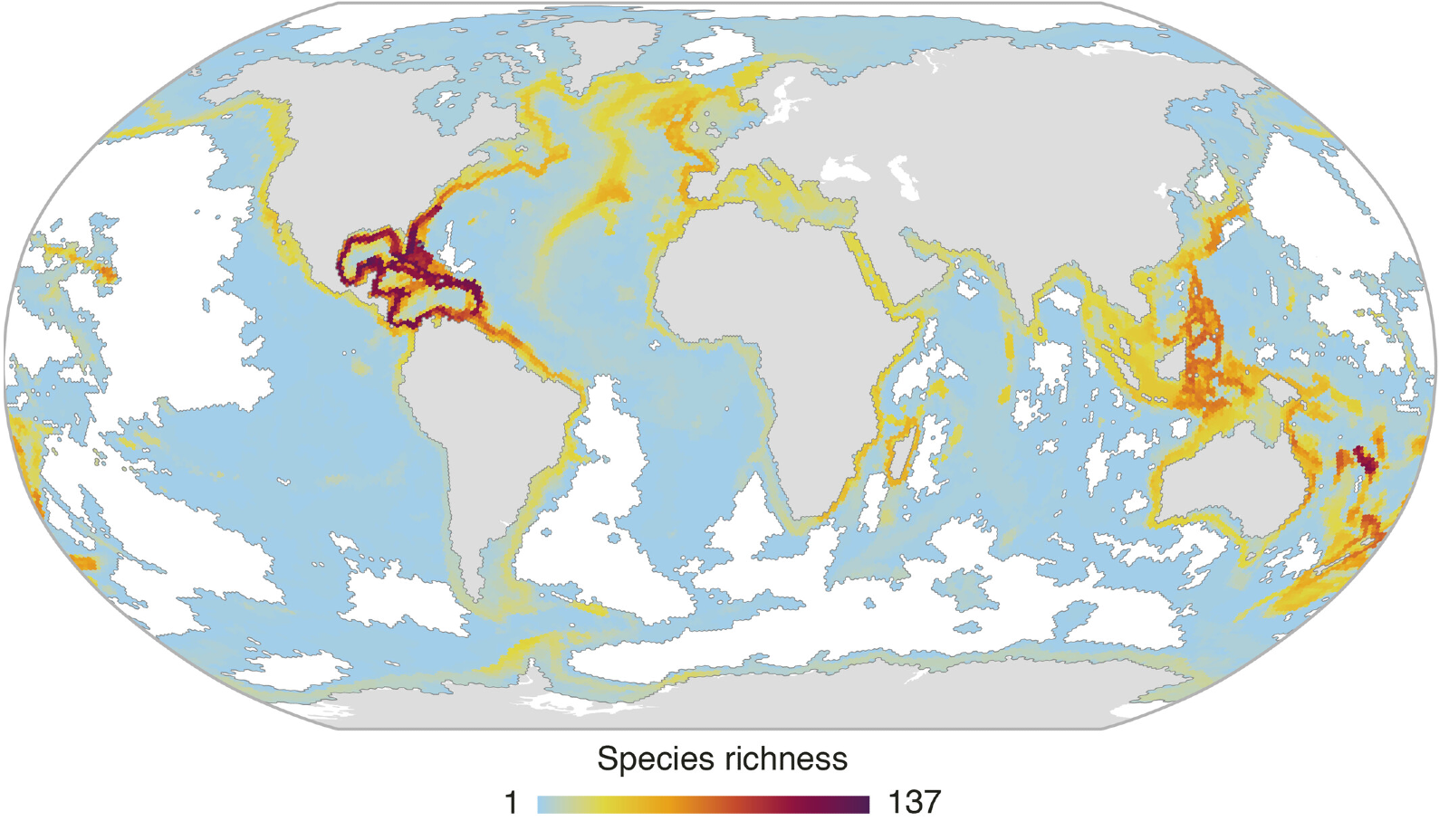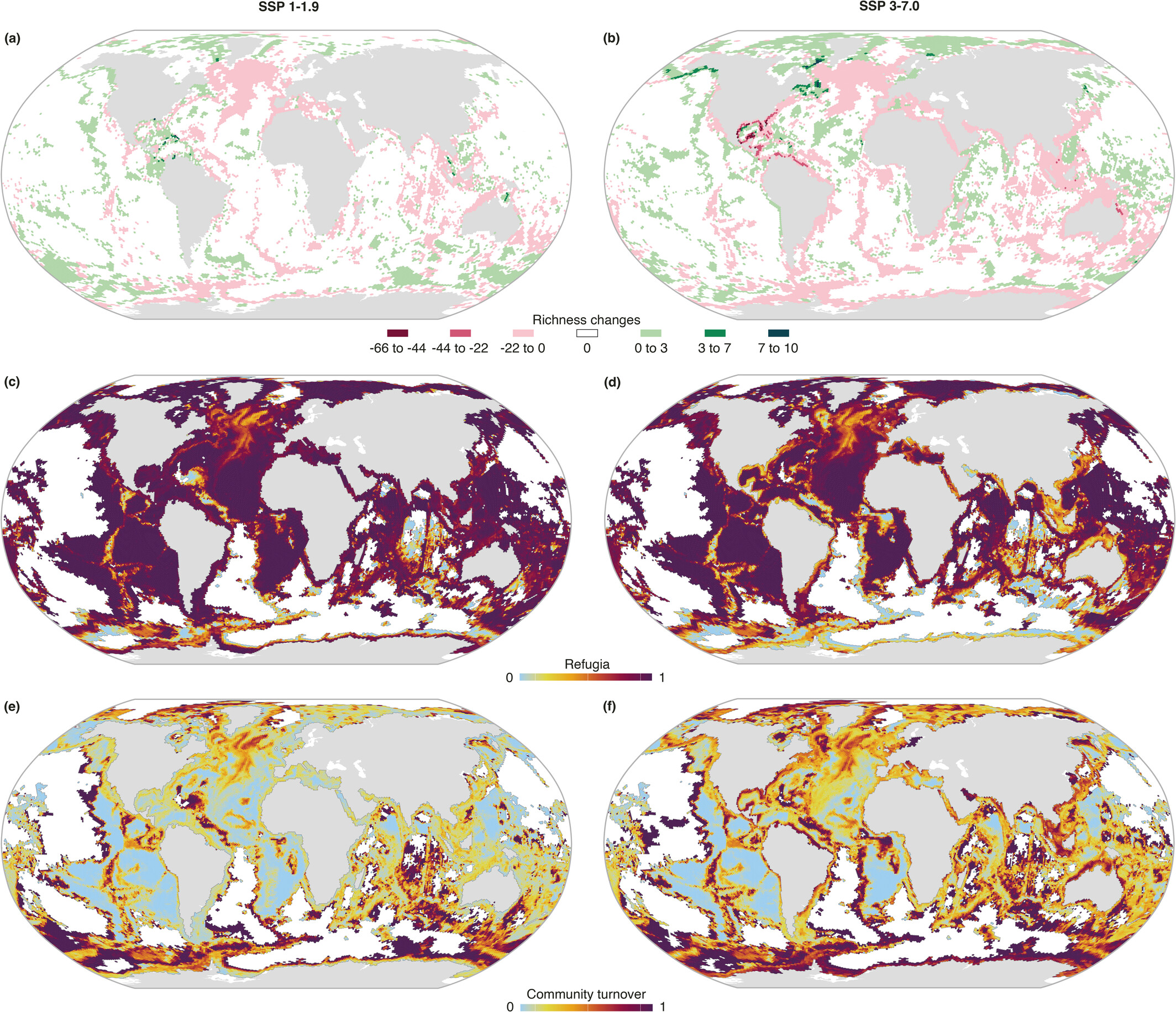Cold-water corals (CWCs) are critical ecosystem-structuring species that provide essential services, from continental shelves to abyssal depths. They create complex, three-dimensional habitats, acting as feeding, breeding, and nursery grounds for a wide range of commercially important fish and invertebrates. Their future, however, is heavily dependent on the planet’s climate trajectory.
The critical knowledge gap
Despite their immense ecological importance, knowledge of the global distribution, diversity patterns, and overall vulnerability of cold-water corals to climate change remains severely limited. This knowledge gap constrains effective, large-scale conservation strategies, particularly the design of robust Marine Protected Areas (MPAs) needed to meet global protection targets.
Our main approach
We conducted the most extensive global assessment of CWC biogeography to date, analyzing 741 species spanning six major taxonomic groups. We used this data to predict species distributions under present-day conditions and project future shifts under two contrasting end-of-century climate scenarios: the low-emission SSP1-1.9 (aligned with the Paris Agreement) and the high-emission SSP3-7.0. Our analysis was based on three pillars:
Mapping global species richness and identifying biodiversity hotspots.
Delineating ten distinct cold-water coral bioregions based on species co-occurrence.
Quantifying projected shifts in species richness, community turnover, and identifying climate refugia.
Technological challenge: how we tackle the study
To accurately model the distribution of these complex, low-dispersal organisms, we employed an ensemble of high-performance machine learning Species Distribution Models (SDMs), including Boosted Regression Trees (BRT), Adaptive Boosting (AdaBoost), and Extreme Gradient Boosting (XGBoost). Our key methodological innovations included:
Monotonicity constraints: We applied ecological constraints to the models (e.g., assuming higher maximum temperature has a negative effect), ensuring the predictions were biologically realistic and reducing the risk of overfitting.
Dispersal constraints: To account for the slow growth rates and limited dispersal of CWCs, we clipped distribution maps using a maximum dispersal constraint of 200km, which significantly reduced overprediction.
Bioregion validation: We used k-means clustering to delineate the ten bioregions and statistically confirmed their distinctiveness using Analysis of Similarities (ANOSIM).
The main finding
Our results showed major biodiversity hotspots in the Gulf of Mexico and the Caribbean Sea, and delineated ten distinct bioregions, each with varying species richness, depth distribution patterns, and generally low levels of endemicity.

Fig. Present-day species richness distribution for 741 species of cold-water corals.
While the global extent of suitable CWC habitat is projected to persist, species-level redistributions will drive dramatic change, with the magnitude strongly tied to emission levels. We identified the Gulf of Mexico and the Caribbean Sea as major present-day biodiversity hotspots. Under the high-emission scenario (SSP3-7.0), we projected:
Widespread poleward and depth shifts, with average species distribution projected to deepen by 26.0m.
Significant biodiversity loss in shallow and low-latitude regions, with the Central Western Atlantic projected to lose up to 66 species.
Richness gains primarily concentrated in deeper offshore areas and the Arctic, indicating potential but fragile new habitats.

Fig. Projected end-of-century changes under SSP1-1.9 and SSP3-7.0 in (a, b) species richness, (c, d) climate refugia, and (e, f) community turnover of cold-water corals. Climate refugia represent the fraction of species predicted to retain suitable habitat (0 = none persist; 1 = all persist). Turnover ranges from 0 (no change in species composition) to 1 (complete replacement). Areas with no species present are shown in white.
Main implications for conservation and management of biodiversity
Our findings underscore the urgent need for global climate action aligned with the Paris Agreement. The study provides an actionable framework to support the UN 2030 Agenda for Sustainable Development and the post-2020 Global Biodiversity Framework.
Prioritizing Conservation: We pinpoint biodiversity hotspots and emerging climate refugia, offering crucial guidance for the strategic designation of new MPAs.
Addressing Synergistic Risks: Our data highlights the amplification of risks in regions like the Gulf of Mexico, where a global CWC hotspot overlaps with major oil and gas extraction zones, requiring immediate, targeted mitigation.
Spatially Explicit Strategies: The ten newly defined bioregions, structured primarily by depth and species composition, enable conservation efforts to be tailored precisely to the unique assemblage of species found in each region.